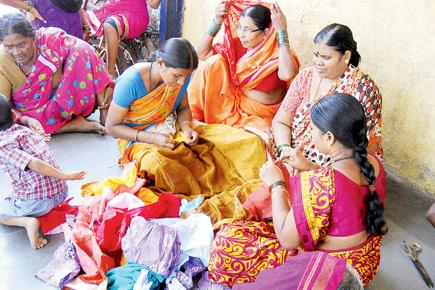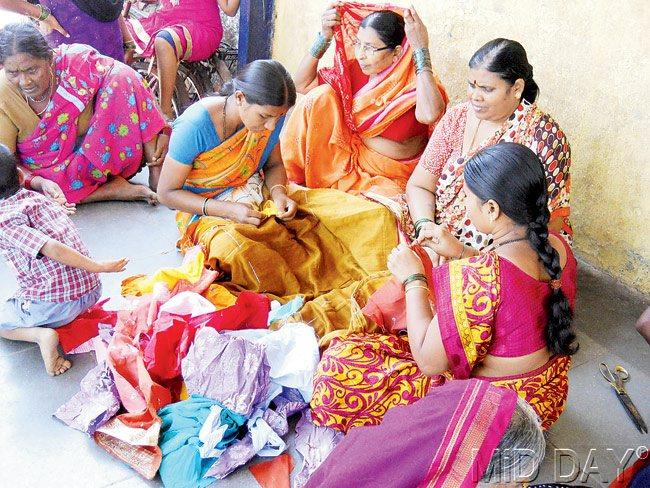35 residents of Samrat Ashok Nagar area in Chakala stitched 150 quilts as part of an artwork that spans 2,000 sq ft of the new terminal at the Mumbai International Airport

The women, who belong to the Siddi community and originally hail from the interiors of Karnataka, had to complete the artwork within three months last year. Pics/ Abhinit Khanna
Art knows no barriers. Hundred-and-fifty quilts that adorn 2,000 sq ft of the recently inaugurated T2 terminal of the Mumbai International Airport Pvt Limited (MIAL) bears testimony to this statement. Designed by 35 women of the Samrat Ashok Nagar area in Chakala, Andheri, this artwork titled Wrapping the Runway is 200 feet broad and 11 feet high and is a part of India Global, one of the six thematic compositions of the art programme titled Jaya Hai that is on display at T2.
The women, who belong to the Siddi community and originally hail from the interiors of Karnataka, had to complete the artwork within three months last year. Pics/ Abhinit Khanna
ADVERTISEMENT
The artwork is the brainchild of Rajeev Sethi, scenographer and principal curator of GVK. He got the idea for roping in locals for this project and giving them an opportunity to display their talent when he saw some quilts (godhadis) designed by them drying on clotheslines at Samrat Ashok Nagar in Andheri East. He found these quilts unique and approached the residents expressing a willingness to buy them. Sethi says, "Godhadis fit perfectly in the theme of India Global, depicting to the world our rich cultural heritage in terms of handicrafts."
Niket Deshpande, who led the design team and closely worked with the locals, says, "After Sethi saw the quilts, he gradually started buying them from the women during his weekly visit to the airport site. It was a sensitive approach towards gaining confidence of the people in the settlement and introducing them to the idea of being involved in one of the largest public art programmes."
He, however, adds that it was a Herculean task to convince the women to participate in the programme. Initially, the architects approached the local senior citizens — Annappa Shinge, Vijay Solanki, Shivanand Poste and Usha Tai Poste — to discuss the idea and convince them. "When Sethi first expressed his desire to buy our quilts, we thought something was wrong with him. When he continued to buy them from us for a couple of days, I finally lost my patience and asked him the reason.
He explained to me the idea and then we were entrusted with the responsibility of convincing the locals," says Usha Tai. The Triratna Mitra Mandal, a youth group of the area, along with Usha Tai and Shivanand Poste, were the co-ordinators between the architects and the women. Shivanand adds, "Initially no one was convinced. It was only after we constantly spoke to them that few of them agreed and started working on the project. They also got their mothers to help. Gradually word spread and everyone co-operated with us."
Stitch by stitch
Deshpande explains, "We organised a workshop for the women for three days. Members of the Triratna Mitra Mandal sourced the cloth material for the artwork from tailors across the city." The locals, who belong to Siddi community and originally hail from the interiors of Karnataka, had to complete the artwork within three months last year. "We generally take 25-30 days for stitching a single quilt but in this case, we had a huge target and less time, so we made groups of four women and each group completed a quilt in seven and a half days," explains Usha Tai.
For structural reasons, the traditional heavy godhadi was transformed into a thinner one with fewer layers. This involved lesser work enabling the locals to finish the project at a faster rate. As most of these women work as domestic help, they stitched the quilts either late at nights or early mornings. They worked in a room near the airport where all the raw material for the quilts was kept. They were also free to work from their homes.
Mounting the artwork
The quilts that form a part of Wrapping The Runway are colour coded. As a result, one can see similar shades of godhadis from one end to another. Each quilt was taken to a tailor to attach a running border around it. This border was stretched and pasted behind the mounting panel, which had fire and water retardant properties. This panel was then secured to the airport panelling and coated with three coats of UV resistant solution to ensure that the quilt didn’t attract any dust for the next 20 years. Each godhadi was numbered as per the colour-coordinated visual and drafted drawings and only then packed and dispatched to site.
Usha Tai is glad that the locals got an opportunity to display their prowess and be a part of this humongous project. "We never thought that someday our work will not only be put up in the new airport but will be highly appreciated by people from all over the world. It was a proud moment for all of us to see our work on television when T2 was inaugurated on January 10. Working on this project has been a significant memory for us," she concludes.
 Subscribe today by clicking the link and stay updated with the latest news!" Click here!
Subscribe today by clicking the link and stay updated with the latest news!" Click here!






